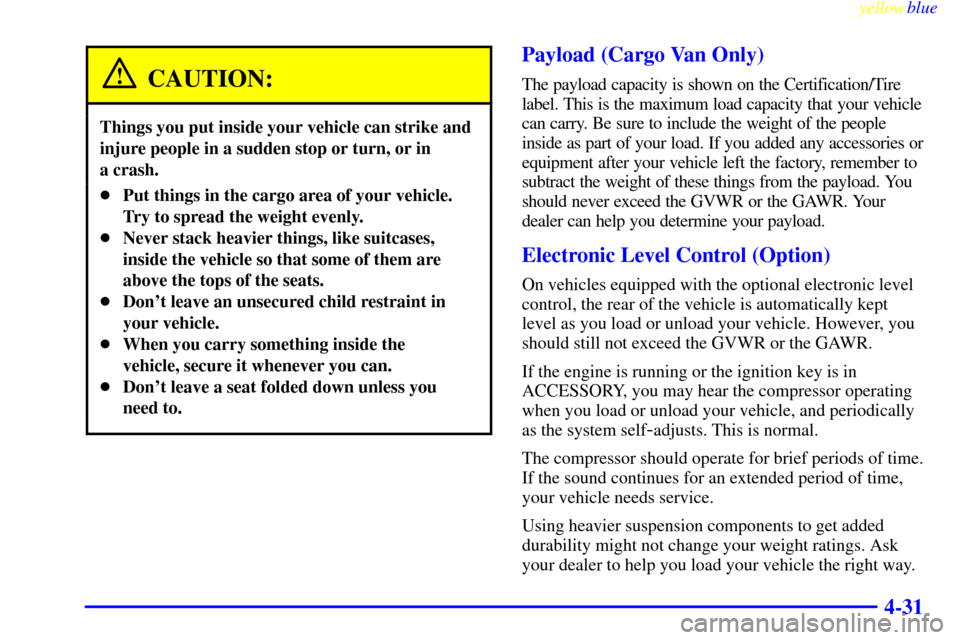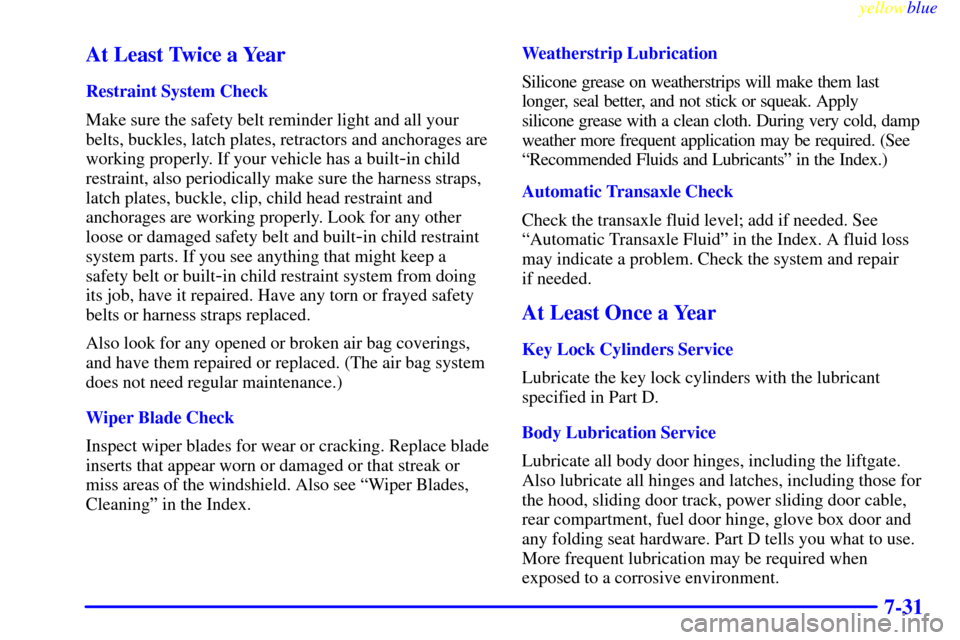Page 200 of 440
yellowblue
2-100Door Ajar Light
This light will come on
when the ignition is turned
to RUN or START and the
driver's/passenger's door or
hatch is open.
It may also come on if a sliding door is not in the fully
latched position.
PASS-Key� III Security Light
If you are ever driving and
this light comes on and
stays on, you will be able to
restart your engine if you
turn it off.
Your PASS
-Key III system, however, is not working
properly and must be serviced by your dealer. Your
vehicle is not protected by the PASS
-Key III system at
this time.
Fuel Gage
United States Canada
When the indicator nears EMPTY (E), you still have a
little fuel left, but you should get more soon.
If your fuel is low, the warning light near the fuel gage
will go on. See ªLow Fuel Warning Lightº later in
this section.
Your fuel gage tells you about how much fuel you have
left when the ignition is on.
Page 239 of 440

yellowblue
4-3
Drunken Driving
Death and injury associated with drinking and driving is
a national tragedy. It's the number one contributor to the
highway death toll, claiming thousands of victims
every year.
Alcohol affects four things that anyone needs to drive
a vehicle:
�Judgment
�Muscular Coordination
�Vision
�Attentiveness.
Police records show that almost half of all motor
vehicle
-related deaths involve alcohol. In most cases,
these deaths are the result of someone who was drinking
and driving. In recent years, over 17,000 annual motor
vehicle
-related deaths have been associated with the use
of alcohol, with more than 300,000 people injured.
Many adults
-- by some estimates, nearly half the adult
population
-- choose never to drink alcohol, so they
never drive after drinking. For persons under 21, it's
against the law in every U.S. state to drink alcohol.
There are good medical, psychological and
developmental reasons for these laws.The obvious way to solve the leading highway safety
problem is for people never to drink alcohol and then
drive. But what if people do? How much is ªtoo muchº
if the driver plans to drive? It's a lot less than many
might think. Although it depends on each person and
situation, here is some general information on
the problem.
The Blood Alcohol Concentration (BAC) of someone
who is drinking depends upon four things:
�The amount of alcohol consumed
�The drinker's body weight
�The amount of food that is consumed before and
during drinking
�The length of time it has taken the drinker to
consume the alcohol.
According to the American Medical Association, a
180
-lb. (82 kg) person who drinks three 12-ounce
(355 ml) bottles of beer in an hour will end up with a
BAC of about 0.06 percent. The person would reach the
same BAC by drinking three 4
-ounce (120 ml) glasses
of wine or three mixed drinks if each had 1
-1/2 ounces
(45 ml) of a liquor like whiskey, gin or vodka.
Page 265 of 440
yellowblue
4-29
Recreational Vehicle Towing
To tow your vehicle, follow these steps:
1. Put the front wheels on a dolly.
2. Put the vehicle in PARK (P).
3. Set the parking brake and then remove the key.
4. Clamp the steering wheel in a straight
-ahead position
with a clamping device designed for towing.
5. Release the parking brake.
Loading Your Vehicle
The Certification/Tire label is found on the rear edge of
the driver's door.
Page 267 of 440

yellowblue
4-31
CAUTION:
Things you put inside your vehicle can strike and
injure people in a sudden stop or turn, or in
a crash.
�Put things in the cargo area of your vehicle.
Try to spread the weight evenly.
�Never stack heavier things, like suitcases,
inside the vehicle so that some of them are
above the tops of the seats.
�Don't leave an unsecured child restraint in
your vehicle.
�When you carry something inside the
vehicle, secure it whenever you can.
�Don't leave a seat folded down unless you
need to.
Payload (Cargo Van Only)
The payload capacity is shown on the Certification/Tire
label. This is the maximum load capacity that your vehicle
can carry. Be sure to include the weight of the people
inside as part of your load. If you added any accessories or
equipment after your vehicle left the factory, remember to
subtract the weight of these things from the payload. You
should never exceed the GVWR or the GAWR. Your
dealer can help you determine your payload.
Electronic Level Control (Option)
On vehicles equipped with the optional electronic level
control, the rear of the vehicle is automatically kept
level as you load or unload your vehicle. However, you
should still not exceed the GVWR or the GAWR.
If the engine is running or the ignition key is in
ACCESSORY, you may hear the compressor operating
when you load or unload your vehicle, and periodically
as the system self
-adjusts. This is normal.
The compressor should operate for brief periods of time.
If the sound continues for an extended period of time,
your vehicle needs service.
Using heavier suspension components to get added
durability might not change your weight ratings. Ask
your dealer to help you load your vehicle the right way.
Page 278 of 440
yellowblue
5-2
Hazard Warning Flashers
Your hazard warning flashers let you warn others. They
also let police know you have a problem. Your front and
rear turn signal lamps will flash on and off.
Your hazard warning
flashers button is on top of
the steering column. Press
the button in to turn on
your flashers.
Your hazard warning flashers work no matter what
position your key is in, and even if the key isn't in.
To turn off the flashers, push the button down and it will
pop back up by itself.
When the hazard warning flashers are on, your turn
signals won't work.
Page 301 of 440
yellowblue
5-25
2. Loosen the wheel
nuts
-- but do not
remove them
-- using
the folding wrench.
(Turn the handle about
180 degrees, then flip
the handle back to the
starting position. This
avoids taking the wrench
off the lug nut for
each turn.)
For wheels with a wheel lock key, use the wheel lock
key between the lock nut and wrench. The key is
supplied in the front passenger's door pocket.NOTICE:
To help avoid damage to the lock nut or the wheel
lock key, do not use an impact wrench with
this key.
Page 369 of 440
yellowblue
6-59
Circuit
BreakersUsage
HEADLAMP DRL Control Module, Headlamp and
Instrument Panel Dimmer Switch
PWR WDO Front Power Windows
PWR SEAT/PSD 6
-Way Power Seat(s) and Rear
Side Door Actuator Motor
FRT HVAC/HI
BLWRBlower Motor Hi Speed
Relay ModuleFuses Usage
SWC
BACKLIGHTSteering Wheel Radio Control
Switches (Illumination)
ELEC PRNDL Instrument Cluster to PRNDL
Indicators
PWR MIRROR Power Remote Control
Mirror Switch
CRUISE Cruise Control Module, Switch
and Release Switch
PWR QTR
VENTInterior Lamps and Multifunction
Switch (Power Vent Switch)
FRT
WPR/WSHRWindshield Wiper/Washer Motor
and Switch
PASS KEY PASS
-Key System
PWR LOCK Body Control Module (BCM)
HTD MIRROR Heated Mirrors
RH T/LP Not Used
RR FOG LP Not Used
CIGAR/DLC Cigarette Lighter and Data Link
Connector (DLC)
T/SIG Turn Signal Switch
RR HVAC Rear Blower Motor, Rear
Heater
-A/C Control, Temperature
Door Actuator (Rear)
Page 407 of 440

yellowblue
7-31 At Least Twice a Year
Restraint System Check
Make sure the safety belt reminder light and all your
belts, buckles, latch plates, retractors and anchorages are
working properly. If your vehicle has a built
-in child
restraint, also periodically make sure the harness straps,
latch plates, buckle, clip, child head restraint and
anchorages are working properly. Look for any other
loose or damaged safety belt and built
-in child restraint
system parts. If you see anything that might keep a
safety belt or built
-in child restraint system from doing
its job, have it repaired. Have any torn or frayed safety
belts or harness straps replaced.
Also look for any opened or broken air bag coverings,
and have them repaired or replaced. (The air bag system
does not need regular maintenance.)
Wiper Blade Check
Inspect wiper blades for wear or cracking. Replace blade
inserts that appear worn or damaged or that streak or
miss areas of the windshield. Also see ªWiper Blades,
Cleaningº in the Index.Weatherstrip Lubrication
Silicone grease on weatherstrips will make them last
longer, seal better, and not stick or squeak. Apply
silicone grease with a clean cloth. During very cold, damp
weather more frequent application may be required. (See
ªRecommended Fluids and Lubricantsº in the Index.)
Automatic Transaxle Check
Check the transaxle fluid level; add if needed. See
ªAutomatic Transaxle Fluidº in the Index. A fluid loss
may indicate a problem. Check the system and repair
if needed.
At Least Once a Year
Key Lock Cylinders Service
Lubricate the key lock cylinders with the lubricant
specified in Part D.
Body Lubrication Service
Lubricate all body door hinges, including the liftgate.
Also lubricate all hinges and latches, including those for
the hood, sliding door track, power sliding door cable,
rear compartment, fuel door hinge, glove box door and
any folding seat hardware. Part D tells you what to use.
More frequent lubrication may be required when
exposed to a corrosive environment.